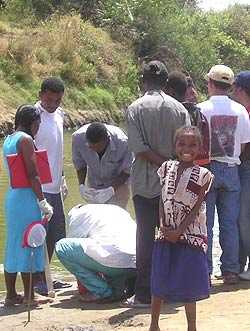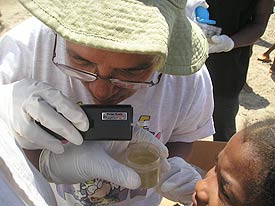Stars and STEM Stories
Madagascar Project Forges New Alliances By Tackling Malaria

In October 2005, 63 students, age 8 to 18, and teachers from Beza Mahafaly and Bezaha Tanosy schools in Madagascar collected and analyzed mosquito larva, studied water salinity to highlight differences among fresh, brackish and mineral water, observed pH and water temperature, studied the form and structure of Anopheles and Culicinae larvae, calculated larval density, and reported parameter results. Working with an impressive team of Malagasy and U.S. scientists, Albert Rafalimanana, Malagasy Country Coordinator, established the protocols used by the students during observations. Two Boulder teachers, Jason Albert and Anitta Frant, and three other Malagasy GLOBE trainers, Paul Randrianarisoa, Rogez Andriamahenina, and Jean Pierre Tsimbazafy assisted Rafalimanana in the teacher trainings prior to the actual field observations by students. The data are currently in the process of being submitted and the Malagasy science community is in discussion about their next steps.

This exciting initiative has already begun to forge alliances and promote collaborative student research using a locally relevant topic, but that is only the first step. Scientists will evaluate not only the data from the project, but the protocols employed during this pilot phase in order to fine tune them and make them applicable in a variety of different regions. "The African continent comprises about 85% of the annual malaria infections, and we hope to make these materials available to GLOBE Partners in other African nations. But these protocols can also be employed in other regions to educate their students and collect data for their regional scientists and community," says Dr. Rebecca Boger, Deputy Director of International/U.S. Partnerships and GLOBE International Project Scientist.
Local identification of mosquito breeding/hatching sites is critical because mosquitoes tend to stay within roughly 1 km of their hatching sites. In developing countries, and particularly in Madagascar, it is entirely possible that GLOBE schools in remote locations could provide the only regular source of this type of data. Thailand and other nations in Southeast Asia have expressed interest in this project and there might be applications in the U.S. as we learn more about the West Nile Virus. According to the Minister Of National Education and Scientific Research, Dr. Hajanirina Razafinjatovo, "by participating in this project, students and teachers will have a deeper awareness of the local and worldwide burden of malaria, as well as how it is transmitted within communities." Dr. Boger adds, "The bottom line is we are creating a regional and global theme of environmental study with immediate relevance to local populations, in this case with critical health applications."
What students learned:
- the consequence of malarial infections on their local communities;
- about the development cycle of the Plasmodium and female Anopheles mosquito's role in the transmission of the disease;
- how to tell the difference between male and female adult mosquitoes;
- about the mosquito's life cycle;
- how to recognize adult breeding sites and times increased infection risk;
- how to recognize main larval lodgings;
- how to differentiate eggs;
- how to differentiate between Anopheles and Culicinae larvae and adults involved or not in the local malaria disease transmission;
- how to evaluate larval density;
- how to calculate the rate of water pollution from mosquitoes indicating polluted water;
- the importance of water temperature, pH , transparency in larval development;
- the importance of air temperature, pH, vapor density in mosquito development
- methods in the integrated fight against larvae.
The GLOBE Program would like to acknowledge the following participants for their hard work and dedication to making the Malaria Project a tremendous success: Research Professors Dr. Lala Rafarasoa, Dr. Ernest Randrianarisoa, Professor Olga Ramiliarijaona, Professor Wilson A. Rajerison, Professor Fanantenanirainy Randimbivololona, Professor Nicole Rakotomanga, all from Antananarivo University in Madagascar, Dr. Michel Ratsimbason, Research Scientist, Dr. Léon Ranaivo-Harimanana, Centre National d'Applications et des Rescherches Pharmaceuticques (CNARP), Dr. David Brooks from Drexel University and Dr. Rebecca Boger.
For more information on the Madagascar Malaria Project, contact Dr. Rebecca Boger.
22 March 2006





